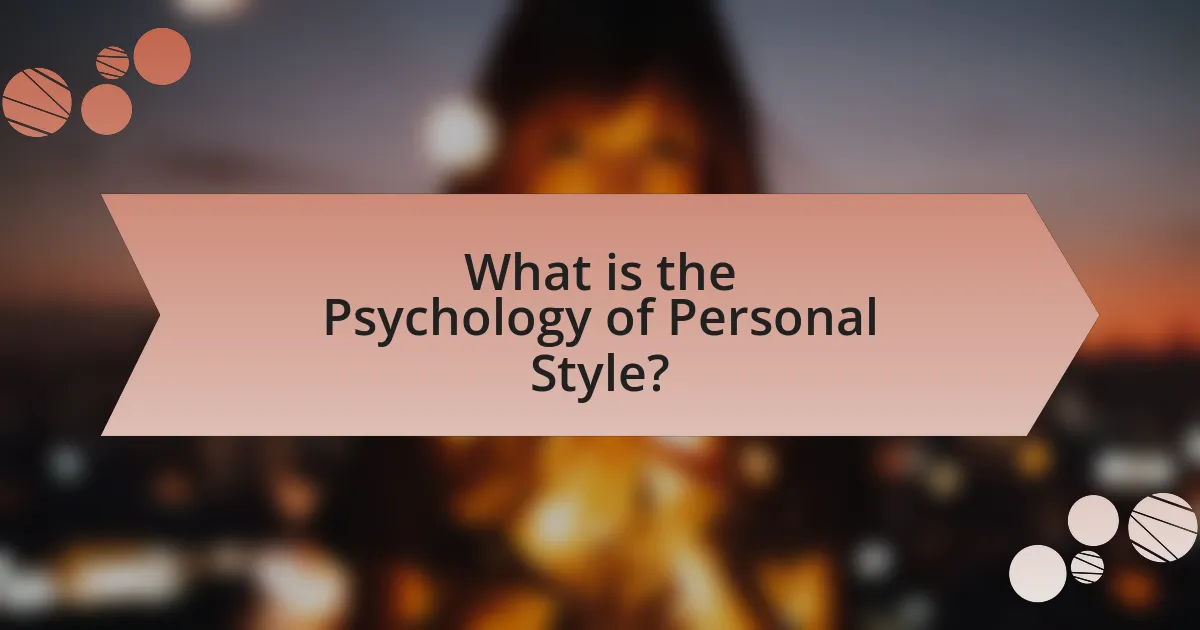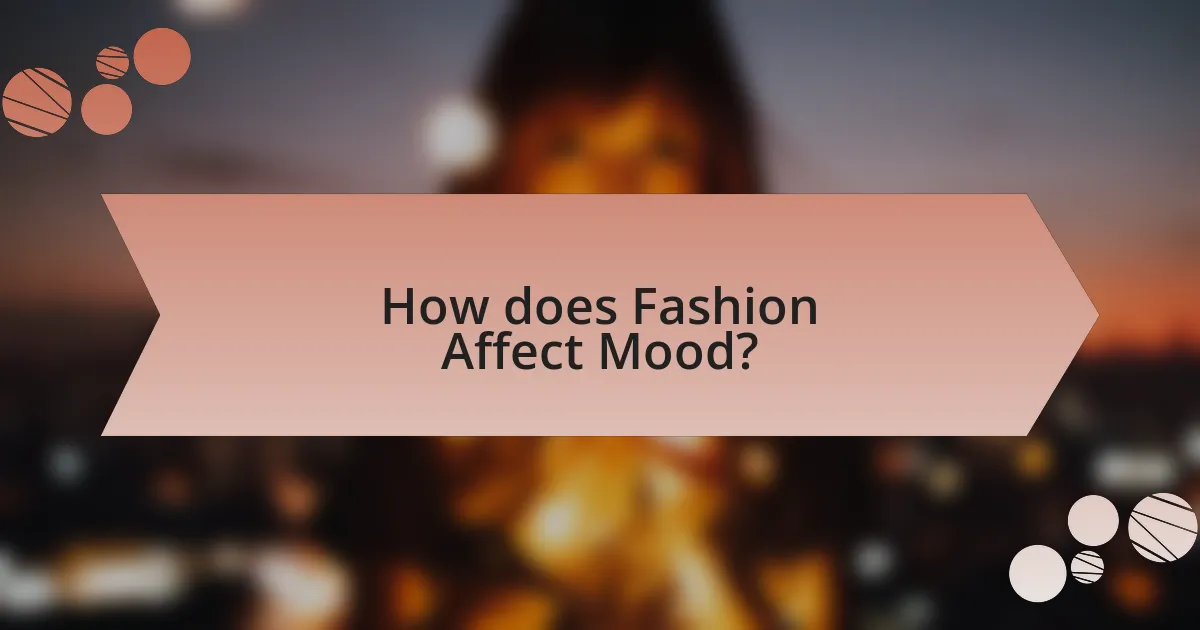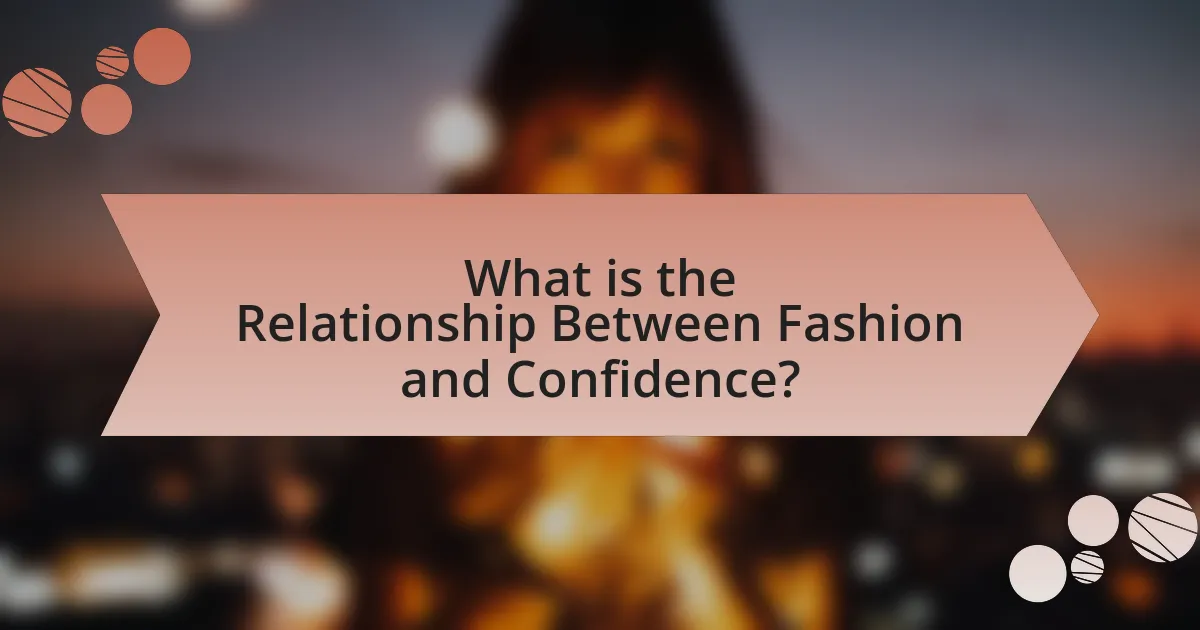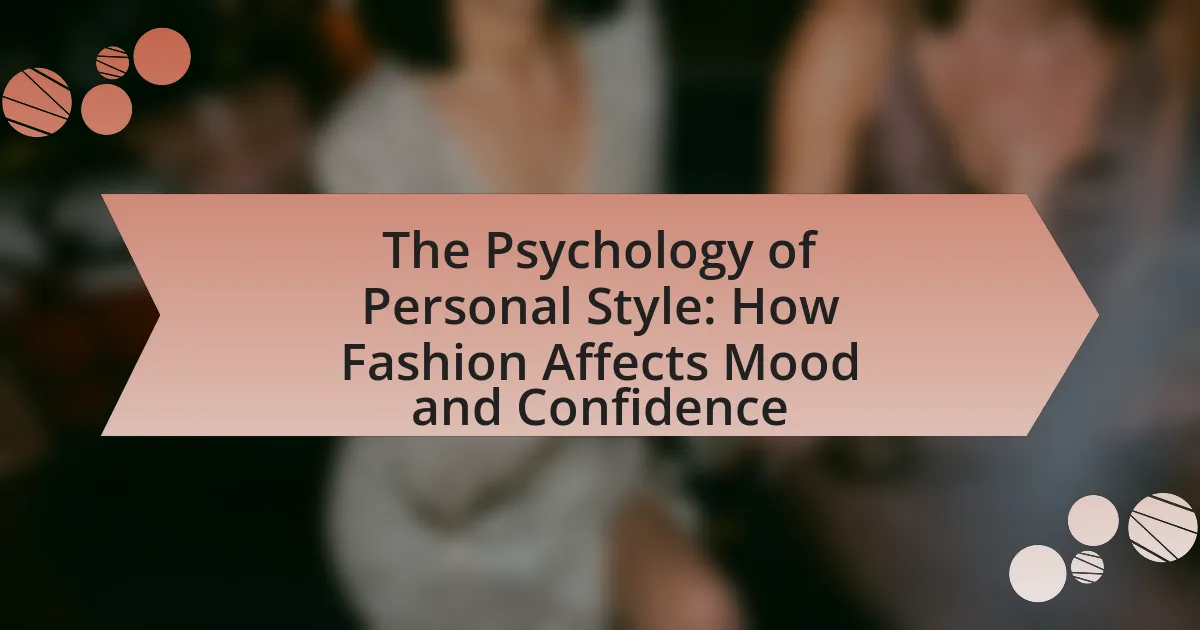The article explores the psychology of personal style, emphasizing how fashion choices reflect and influence individual identity, emotions, and social interactions. It discusses the impact of clothing on self-perception, confidence, and cognitive function, supported by research findings. Key concepts include the relationship between personal style and mental well-being, the psychological effects of color and fit in clothing, and the cultural associations of fashion. Additionally, the article highlights strategies for enhancing personal style and confidence through thoughtful fashion choices.

What is the Psychology of Personal Style?
The psychology of personal style refers to the ways in which individual fashion choices reflect and influence one’s identity, emotions, and social interactions. Personal style serves as a form of self-expression, allowing individuals to communicate their personality, values, and mood through clothing and accessories. Research indicates that clothing can significantly affect self-perception and behavior; for example, a study published in the Journal of Experimental Social Psychology found that participants wearing formal attire performed better on cognitive tasks compared to those in casual clothing, highlighting the impact of fashion on confidence and cognitive function. Thus, personal style not only shapes how individuals see themselves but also how they are perceived by others, reinforcing the connection between fashion, mood, and self-esteem.
How does personal style influence individual identity?
Personal style significantly influences individual identity by serving as a form of self-expression that communicates personal values, beliefs, and social affiliations. This expression is evident in how individuals curate their clothing choices, which can reflect cultural backgrounds, personal experiences, and emotional states. Research indicates that clothing can affect self-perception and how others perceive an individual, with studies showing that people often make judgments about personality traits based on attire. For example, a study published in the Journal of Experimental Social Psychology found that individuals dressed in formal attire were perceived as more competent and authoritative, highlighting the impact of style on identity formation and social interactions.
What psychological theories explain the connection between fashion and self-perception?
Psychological theories that explain the connection between fashion and self-perception include the Social Identity Theory and the Symbolic Interactionism Theory. Social Identity Theory posits that individuals derive part of their self-concept from their group memberships, which can be influenced by fashion choices that signify belonging to specific social groups. For example, wearing designer brands may enhance an individual’s self-esteem by aligning them with a perceived higher social status. Symbolic Interactionism Theory suggests that individuals interpret and give meaning to their clothing choices, which in turn affects their self-perception and behavior. Research indicates that clothing can influence mood and confidence, as demonstrated in a study by Adam and Galinsky (2012), which found that participants wearing formal clothing performed better on cognitive tasks, highlighting the impact of fashion on self-perception and cognitive function.
How does personal style reflect cultural and social influences?
Personal style reflects cultural and social influences by serving as a visual representation of an individual’s identity shaped by their environment. Cultural elements such as traditions, values, and historical context inform choices in clothing, accessories, and overall aesthetics. For instance, the adoption of specific garments like the kimono in Japan or the dashiki in West Africa illustrates how fashion embodies cultural heritage. Social influences, including peer groups and societal norms, also dictate style preferences, as individuals often align their fashion choices with those of their community to foster belonging. Research indicates that clothing can communicate social status and group affiliation, further emphasizing the interplay between personal style and cultural identity.
Why is understanding personal style important for mental well-being?
Understanding personal style is important for mental well-being because it allows individuals to express their identity and boost their self-esteem. When people align their clothing choices with their personal preferences, they often experience increased confidence and a positive self-image. Research indicates that wearing clothes that reflect one’s personal style can enhance mood and reduce anxiety, as individuals feel more authentic and comfortable in their appearance. For instance, a study published in the Journal of Experimental Social Psychology found that participants who dressed in a way that resonated with their self-concept reported higher levels of self-esteem and overall satisfaction. This connection between personal style and mental well-being underscores the significance of fashion as a tool for emotional expression and psychological health.
How can fashion choices impact mood and emotional state?
Fashion choices significantly impact mood and emotional state by influencing self-perception and social interactions. When individuals wear clothing that aligns with their personal style or makes them feel confident, they often experience increased self-esteem and positivity. Research published in the Journal of Experimental Social Psychology indicates that clothing can affect cognitive processes and emotional responses; for example, wearing formal attire can enhance abstract thinking and boost confidence levels. Additionally, colors and styles can evoke specific emotions; for instance, wearing bright colors is associated with feelings of happiness, while darker colors may evoke sadness or seriousness. Thus, the psychological effects of fashion choices are evident in how individuals feel about themselves and how they are perceived by others.
What role does personal style play in building self-esteem and confidence?
Personal style significantly enhances self-esteem and confidence by allowing individuals to express their identity and feel more comfortable in their own skin. When people curate their personal style, they often experience a boost in mood and self-perception, as clothing choices can reflect personal values and preferences. Research indicates that wearing clothes that align with one’s self-image can lead to increased feelings of empowerment and self-worth. For instance, a study published in the Journal of Experimental Social Psychology found that participants who wore formal clothing performed better on cognitive tasks, suggesting that attire can influence psychological states and self-assurance. Thus, personal style serves as a powerful tool for fostering confidence and enhancing overall self-esteem.

How does Fashion Affect Mood?
Fashion significantly affects mood by influencing self-perception and emotional state. When individuals wear clothing that they feel confident and comfortable in, it can lead to increased self-esteem and a positive outlook. Research indicates that clothing can evoke specific emotions; for instance, wearing bright colors is often associated with feelings of happiness, while darker colors may evoke sadness or seriousness. A study published in the Journal of Experimental Social Psychology found that participants who wore formal clothing performed better on cognitive tasks, suggesting that fashion choices can enhance mental clarity and confidence. Thus, the interplay between fashion and mood is evident, as clothing choices can directly impact emotional well-being and self-image.
What are the psychological effects of color in clothing?
The psychological effects of color in clothing significantly influence mood and perception. For instance, wearing red can evoke feelings of excitement and passion, while blue is often associated with calmness and stability. Research by the University of California found that colors can affect emotional responses; for example, yellow is linked to happiness and optimism, whereas black can convey authority or sadness. These associations are rooted in cultural contexts and personal experiences, demonstrating that color choices in clothing can impact not only the wearer’s mood but also how others perceive them.
How do different colors influence emotions and perceptions?
Different colors significantly influence emotions and perceptions by evoking specific psychological responses. For instance, red is often associated with excitement and passion, while blue tends to evoke feelings of calmness and trust. Research conducted by the Institute for Color Research indicates that people make subconscious judgments about a person, environment, or product within 90 seconds of initial viewing, and 62-90% of that assessment is based on color alone. Additionally, yellow can stimulate feelings of happiness and energy, whereas green is linked to tranquility and health. These associations are not only culturally influenced but also have biological underpinnings, as colors can affect physiological responses, such as heart rate and hormone levels.
What are the cultural associations of specific colors in fashion?
Colors in fashion carry significant cultural associations that influence perceptions and emotions. For example, red is often associated with passion and power in many cultures, while in some Eastern cultures, it symbolizes luck and prosperity. Blue typically conveys calmness and trustworthiness, making it a popular choice in professional attire. In contrast, black is frequently linked to sophistication and formality in Western contexts, but in some cultures, it may represent mourning. Yellow is often seen as a symbol of happiness and optimism, yet in certain contexts, it can signify caution. These associations are rooted in historical and cultural contexts, shaping how individuals express themselves through fashion choices.
How do clothing styles impact feelings of comfort and confidence?
Clothing styles significantly impact feelings of comfort and confidence by influencing both physical sensations and psychological perceptions. When individuals wear clothing that fits well and aligns with their personal style, they often experience increased comfort, which can enhance their overall mood. Research indicates that wearing clothes that one perceives as stylish or appropriate can boost self-esteem and confidence levels. For instance, a study published in the Journal of Experimental Social Psychology found that participants who wore formal clothing performed better on cognitive tasks, suggesting that clothing can affect mental state and self-perception. Thus, the choice of clothing style directly correlates with emotional well-being and self-assurance.
What styles are commonly associated with empowerment and confidence?
Styles commonly associated with empowerment and confidence include tailored suits, bold colors, and statement accessories. Tailored suits convey professionalism and authority, often leading to increased self-assurance in various settings. Bold colors, such as red or royal blue, are linked to heightened confidence levels, as studies show that wearing vibrant hues can positively influence mood and perception. Statement accessories, like oversized jewelry or distinctive shoes, serve as focal points that enhance personal expression and assertiveness. Collectively, these styles contribute to a powerful self-image and can significantly impact an individual’s confidence in social and professional environments.
How does the fit of clothing affect self-image and mood?
The fit of clothing significantly impacts self-image and mood by influencing how individuals perceive themselves and how they are perceived by others. When clothing fits well, it can enhance confidence and promote a positive self-image, leading to improved mood. Conversely, poorly fitting clothing can lead to feelings of discomfort and self-consciousness, negatively affecting mood and self-esteem. Research indicates that individuals who wear well-fitting clothes report higher levels of satisfaction with their appearance, which correlates with increased self-confidence and a more positive emotional state. For instance, a study published in the journal “Psychology of Fashion” found that participants wearing tailored clothing experienced greater feelings of power and self-assurance compared to those in ill-fitting garments.

What is the Relationship Between Fashion and Confidence?
Fashion significantly influences confidence by shaping self-perception and social interactions. When individuals wear clothing that aligns with their personal style and makes them feel good, they often experience an increase in self-esteem and assertiveness. Research published in the Journal of Experimental Social Psychology indicates that clothing can affect cognitive processes and behavior, demonstrating that people who dress in a way that they perceive as stylish or appropriate are more likely to exhibit higher levels of confidence in social situations. This relationship is further supported by studies showing that individuals who engage in fashion that reflects their identity report feeling more empowered and capable, reinforcing the idea that fashion serves as a tool for enhancing personal confidence.
How does dressing well contribute to a positive self-image?
Dressing well significantly contributes to a positive self-image by enhancing an individual’s confidence and influencing how they are perceived by others. When individuals wear clothing that they feel good in, it can lead to increased self-esteem and a more favorable self-perception. Research published in the Journal of Experimental Social Psychology indicates that clothing can affect cognitive processes and self-evaluation, suggesting that well-dressed individuals often experience a boost in mood and confidence. This positive self-image is further reinforced by social feedback; people tend to respond more favorably to those who present themselves well, creating a cycle of affirmation that enhances self-worth.
What are the psychological benefits of dressing for success?
Dressing for success enhances self-esteem and confidence, leading to improved performance in various settings. Research indicates that individuals who dress well perceive themselves more positively, which can translate into greater assertiveness and motivation. A study published in the Journal of Experimental Social Psychology found that participants wearing formal attire performed better on cognitive tasks compared to those in casual clothing, demonstrating the impact of clothing on mental acuity and focus. Additionally, dressing professionally can influence how others perceive an individual, often leading to increased respect and authority in social and professional interactions.
How can personal style choices enhance social interactions?
Personal style choices can enhance social interactions by fostering connections and facilitating communication. When individuals express themselves through their clothing and accessories, they signal their personality, values, and social identity, which can attract like-minded people and initiate conversations. Research indicates that people often make judgments about others based on their appearance within seconds, influencing first impressions and social dynamics. For instance, a study published in the Journal of Experimental Social Psychology found that individuals who dress in a way that aligns with social norms are perceived as more approachable and trustworthy, thereby enhancing their social interactions.
What strategies can individuals use to improve their personal style?
Individuals can improve their personal style by identifying their body type and selecting clothing that enhances their best features. Understanding body shape allows individuals to choose silhouettes that flatter their figure, which can boost confidence and mood. For instance, research indicates that wearing well-fitted clothing can positively impact self-esteem and how others perceive an individual, as noted in a study published in the Journal of Experimental Social Psychology. Additionally, experimenting with colors and patterns that complement one’s skin tone can further enhance personal style, as color psychology suggests that certain hues can influence emotions and perceptions. Lastly, curating a versatile wardrobe with staple pieces enables individuals to mix and match outfits, fostering creativity and personal expression in their style choices.
How can one identify their personal style effectively?
To identify personal style effectively, one should analyze their preferences, influences, and lifestyle. This involves reflecting on favorite colors, patterns, and silhouettes, as well as considering how different styles make them feel. Research indicates that personal style is closely linked to self-expression and emotional well-being; for instance, a study published in the Journal of Experimental Social Psychology found that clothing choices can significantly impact mood and confidence. By experimenting with various outfits and observing reactions, individuals can refine their style to align with their identity and emotional needs.
What practical tips can enhance confidence through fashion choices?
Wearing clothing that fits well enhances confidence by improving self-image. Well-fitted clothes create a polished appearance, which can lead to positive feedback from others and boost self-esteem. Additionally, choosing colors that complement one’s skin tone can elevate mood; studies show that colors like blue and green are associated with calmness and confidence. Accessorizing appropriately, such as wearing statement pieces, can also draw attention and create a focal point, further enhancing confidence. Lastly, dressing for the occasion ensures that individuals feel prepared and appropriate, which can significantly impact their confidence levels in social situations.
